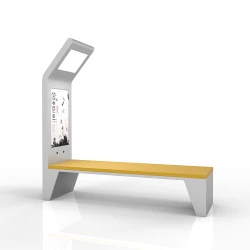Here are key aspects related to benches
2023-12-29
Benches are simple and versatile pieces of furniture designed for seating and are commonly found in various indoor and outdoor settings. They serve practical and aesthetic purposes, providing individuals with a place to sit, rest, or socialize. Benches come in a wide range of styles, materials, and designs to suit different environments. Here are key aspects related to benches:
1. Materials:
- Wooden Benches: Traditional and classic, wood benches are popular for their natural aesthetics. They may be made from hardwoods like teak or more affordable softwoods.
- Metal Benches: Durable and often used in public spaces, metal benches can be made from materials like cast iron, aluminum, or steel.
- Concrete Benches: Sturdy and low-maintenance, concrete benches are suitable for outdoor use and can have various finishes.
2. Styles:
- Backless Benches: Simple benches without a backrest, suitable for informal settings.
- Backed Benches: Benches with a backrest for added comfort and support.
- Storage Benches: Benches with built-in storage space, often used indoors or on patios.
- Garden Benches: Designed with aesthetics in mind, garden benches may have ornate details and are often made of weather-resistant materials.
- Park Benches: Sturdy and utilitarian, park benches are commonly found in public spaces and may have armrests for additional comfort.
3. Design Features:
- Curved Benches: Benches with a curved shape for a more dynamic and visually interesting design.
- Straight Benches: Simple and straightforward in design, suitable for various settings.
- Custom Designs: Some benches are designed with specific themes, patterns, or artistic elements, especially in public spaces and parks.
4. Seating Capacity:
- Single Benches: Designed for one person.
- Double Benches: Wider benches designed for two or more people.
5. Indoor vs. Outdoor Benches:
- Indoor Benches: Often designed with comfort and style in mind, indoor benches may have upholstered seats and complement interior decor.
- Outdoor Benches: Built to withstand weather conditions, outdoor benches are typically made from materials resistant to moisture and UV rays.
6. Installation:
- Freestanding Benches: Portable and can be moved to different locations.
- Built-In Benches: Integrated into architectural elements, such as walls or planter boxes.
- Floating Benches: Suspended or floating off the ground, providing a modern and airy look.
7. Maintenance:
- Low-Maintenance Benches: Materials like metal or concrete often require less maintenance than wood, which may need regular sealing or staining.
- Weather Resistance: Consider the weather conditions of the intended location and choose benches with appropriate weather-resistant features.
8. Accessibility:
- ADA-Compliant Benches: In public spaces, benches should comply with accessibility standards, ensuring they are usable by individuals with disabilities.
9. Comfort Features:
- Cushions: Some benches, especially indoor or garden benches, may have cushions for added comfort.
- Contoured Seats: Seats with a contoured or ergonomic design for enhanced comfort.
10. Usage Context:
- Commercial Settings: Benches in commercial spaces like shopping malls, airports, or waiting areas may prioritize durability and ease of maintenance.
- Residential Settings: Benches in homes and gardens may emphasize comfort and aesthetics.
Benches are versatile pieces of furniture that can enhance the functionality and style of various spaces. The choice of a bench depends on the specific needs of the environment, the desired aesthetic, and considerations such as durability and maintenance.



